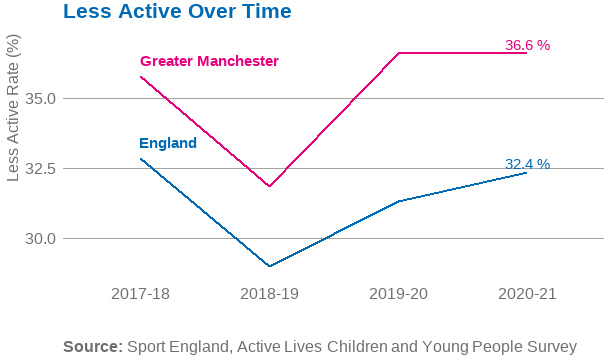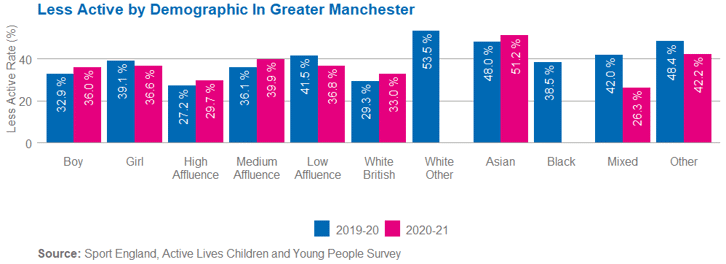Greater Manchester Children & Young People Activity Levels 2020/21
41.7% of children and young people in Greater Manchester meet Chief Medical Officer guidelines and achieve an average of 60 minutes or more of physical activity a day. Whilst 36.6% are failing to achieve 30 minutes of physical activity a day.
The latest Active Lives Children and Young People Survey data from Sport England has been released and has highlighted the impact Covid-19 has had on the activity levels of children and young people. Just 63.4% of children and young people in Greater Manchester (GM) are moving, achieving at least 30 minutes of physical activity a day, this is lower than the national rate of 67.6%. In the last academic year it is promising to see that there has been no significant change from baseline (2017/18).

Overall, 41.7% of children and young people are active, average 60+ minutes of physical activity every day, 21.7% are fairly active, achieve an average of 30-59 minutes of physical activity a day, and 36.6% are inactive, do less than 30 minutes of physical activity a day.
Borough Level Data

Inactivity rates vary considerably across Greater Manchester with there being a 17.2% gap between the borough with lowest levels of inactivity, Wigan (27.1%), and the borough with the highest levels of inactivity, Rochdale (44.3%). This gap between boroughs has grown by 4.4% since the last release when there was an 12.8% gap.
Demographics

Across Greater Manchester we see a difference across demographics with less active rates higher than the GM average amongst Asian and Other ethnicities. There has been a significant decrease amongst Mixed ethnicities (-15.7%) and low family affluence (-4.7%). Boys, although previously below average for less active have seen an increase (3.1%), whilst girls have seen a decrease (-2.5%). This does align with the national picture, boys have been particularly affected by Covid-19 and lockdown due to the restrictions on activity choice.
- Some of the data has been suppressed because they have less than 150 responses in total or only 1-2 responding schools in the LA meaning the data is insufficiently reliable
- Due to limited samples in some cases where there is large changes you might assume the scale is exaggerated but the direction is likely, with smaller changes we would recommend not relying on these.
Published January 2021
